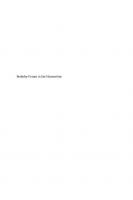Persephone's Quest: Entheogens and the Origins of Religion 9780300138146
This fascinating book discusses the role played by psychoactive mushrooms in the religious rituals of ancient Greece, Eu
223 102 14MB
English Pages 256 [255] Year 2008
Recommend Papers

- Author / Uploaded
- R. Gordon Wasson
- Stella Kramrisch
- Carl Ruck
- Jonathan Ott
File loading please wait...
Citation preview
PERSEPHONE'S QUEST
Persephone Gathering Wild Flowers Wall painting from Stabiae. Naples, Museo Nazionale.
PERSEPHONE'S QUEST:
Entheogens and the Origins of Religion R. Gordon Wasson, Stella Kramrisch, Jonathan Ott, and Carl A. P. Ruck
YALE UNIVERSITY PRESS New Haven and London
This book originally appeared in a privately printed edition in a larger format.
Copyright © 1986 by R. Gordon Wasson. All rights reserved. This book may not be reproduced, in whole or in part, including illustrations, in any form (beyond that copying permitted by Sections 107 and 108 of the U.S. Copyright Law and except by reviewers for the public press), without written permission from the publishers. Printed in the United States of America. Library of Congress catalog card number: 87-51547 International standard book number: 0-300-03877-1 (cloth) 0-300-05266-9 (pbk.) A catalogue record for this book is available from the British Library. The paper in this book meets the guidelines for permanence and durability of the Committee on Production Guidelines for Book Longevity of the Council on Library Resources. 8
10
9
7
' We have no knowledge . . . but what has been built up by pleasure, and exists in us by pleasure alone . . . The knowledge both of the Poet and the Man of Science is pleasure.' Wordsworth's insistence in the 1802 preface to the Lyrical Ballads on the inseparable association of knowledge and pleasure takes us straight to a profound conjunction in the work of scientist and creative writer . . . The 'happy ending' of successful theorizing, satisfactory experiment, achieved work of art, creates pleasure. And so does the process, or story, of discovery. Gillian Beer, TLS, 2 Nov. 1984, p. 1255
This page intentionally left blank
TABLE OF CONTENTS
PART ONE Entheogens and the Origins of Religion Page
Prelude
16
CHAPTER 1 Persephone's Quest by R. Gordon Wasson Interlude Our discoveries: 1. Soma and the Vedic Culture 32. 2. The Mystery of Eleusis 33. 3. Our first Velada 33. 4. The Grecas 38. 5. The New World and the Thunderbolt 45. 6. The Meaning of Kakuljd Huracan 47. 7. A Glimpse of the Domestic Use of Soma 54. 8. The Chinese and the Nivkhi 57. 9. Greece and Soma 60. 10. Soma among the Mediaeval 'Monsters' 63. II. The Chukotka 68. 12. The Fool's Mushroom 68. 13. 'Happiness Mushroom' 72. 14. The British and the 'Nameless Mushroom' 73. 15. The Vikings and Soma 74. 16. The Tree of the Knowledge of Good and Evil 74. Epilogue: the Age of the Entheogens Unfinished Business
17 30
78 81
CHAPTER 2 Lightningbolt and Mushrooms by R. Gordon Wasson
83
CHAPTER 3 The Mahavlra Vessel and the Plant Putika by Stella Kramrisch The Secret of the cut-off Heads The Elixir of Life: Soma and Putika Putka and the Santal of Eastern Bihar The Mahavira Vessel The later and separate Lives of Mahāvāīra and Putika
95 95 102 106 109 112
CHAPTER 4 The Last Meal of the Buddha by R. Gordon Wasson What was Sūkara-Maddava'? The Santal and the Putka 9
117 117 123
TABLE OF CONTENTS The Buddha's Last Meal The Indus Valley and Kashmir Memorandum by Walpola Rāhula on the early Sources for the Meaning of Sūkaramaddava Epilogue
132 134 137 138
CHAPTER 5 Carved 'Disembodied Eyes' of Teotihuacan by Jonathan Ott
141
PART TWO Poets, Philosophers, Priests: Entheogens in the Formation of the Classical Tradition by Carl A. P. Ruck
CHAPTER 6 Mushrooms and Philosophers Shade-foots The Scene of Necromancy Peisander and the Affair of the Profanations The Swamp of Dionysus Tongue-in-Bellies and Revealers Socrates as Profaner of the Mysteries Mushrooms Aja Ekapād Prometheus as Shade-foot and the Theft of Fire Philosophers
151 151 152 153 156 157 159 160 165 169 176
CHAPTER 7 The Wild and the Cultivated: Wine in Euripides' Bacchae The Discovery of Wine The Reconciliation with Primitivism The Making of Wine The mad Ring and the God Double Birth and the God's Surrogate The first Birth The second Birth The Paradigm of Actaeon 10
179 180 191 194 198 200 202 209 210
TABLE OF CONTENTS The Regression of Cadmean Thebes From Pollution to Fertility Toward an Understanding of Tragedy
212 216 219
CHAPTER 8 The Offerings from the Hyperboreans Introduction The Route for the Offerings Hyperboreans The Garden of Apollo Lycians Apollo Sacrifice Thargelia Soma Daphnephoria The Secret Offering
225 225 226 227 230 233 236 238 240 248 249 250
Notes on the Essays in this Book
257
11
This page intentionally left blank
LIST OF ILLUSTRATIONS CHAPTER ONE Page Wall Painting from Stabiae. Naples, Museo Nazionale.
Frontispiece
Fig. 1 Aurelio Carreras, Sabio, and his son Mauro, 5 July 1955.
34
Fig. 2 Archaic Greek amphora, found at Eleusis.
38
Fig. 3 Copper swastikas, found in Hopewell mounds of Ohio, ca AD 500.
39
Fig. 4 A bee goddess with animals, birds, and swastikas, found in Boeotia, dating from ca BC 700. Gimbutas: 'Old Europe'.
40
Fig. 5 'Old Europe': Marija Gimbutas. Map of Old Europe; with 'grecas' or frets, found there that date from BC 5000 to BC 3500.
42/43
Fig. 6 A farmer's cottage in Orissa, India, in Santal country.
44
Fig. 7 Aristeo Matías, Sabio, center; Roberto Weitlaner, right; interpreter, left.
45
Fig. 8 Terra cotta figurines suggestive of Soma, ca AD 100, from Mexico, discovered by Peter T. Furst.
51
Fig. 9 The Black Tezcatlipoca, in aspect of Huitzilopochtli: he is uniped, 'hurakari.
52
Fig. 10 lambe-Baubo Figures, Terra cotta, Priene, Asia Minor. V century BC.
63
Fig. 11 'Monsters' representing Soma, frequently reproduced in manuscripts and early printed books of western Europe. a. Single-footed man b. Cyclopes c. 'Tongue-in-Belly' d. Drawing of group with other 'Monsters', e. Scenes from mediaeval manuscript of Marco Polo's travels f. Reproduction of the 'Folk with but One Foot' from The Travels of Sir John Mandeville, Kt. 65/67
13
LIST OF ILLUSTRATIONS
Fig. 12 Map of the Chukotka region and chart of mushroom shapes.
69
Fig. 13 N.N.Dikov, copying petroglyphs and view of mushroom carvings.
70
Fig. 14 One-sided man, or 'unilateral figure', or 'halfling'.
80
CHAPTER FIVE Fig. 1 'Predella' from Zacuala, Teotihuacan, repainted by the late Abel Mendoza.
141
Fig. 2 Drops of entheogenic potion with appended 'disembodied eyes' from Teotihuacan murals.
141
Fig. 3 and 4. Drops of entheogenic potion and appended 'disembodied eyes' issuing from entheogenicflowers.
142
Fig. 5 Gold ring of Isopata near Knossos, greatly enlarged. Scene depicts epiphany of goddess (presumably Artemis) on the right, and four worshippers, all represented as anthropomorphic bees.
142
Fig. 6 Looking north at Teotihuacan, with Pyramid of the Moon at right and Palace of Quetzalpápalotl at left in foreground.
143
Fig. 7 Entrance to Palace of Quetzalpapálotl at Teotihuacan.
144
Fig. 8 Column showing Quetzalpapálotl chimera and 'disembodied eyes'.
144
Fig. 9 Closeup of 'disembodied eye' from column.
145
Fig. 10 Closeup of 'disembodied eyes'.
145
Fig. 11 West column with frontal view of avian creature and 'disembodied eyes'.
145
Fig. 12 West side of courtyard, showing columns surmounted by painted lintel and carved stone 'combs'.
146
14
Prelude In the opening chapter of my SOMA I said that there always hovered in my mind's eye the admonitory finger of Tristram Shandy's warning against the occupational hazard of those who advance hypotheses: It is in the nature of a hypothesis when once a man has conceived it, that it assimilates everything to itself, as proper nourishment, and from the first moment of your begetting it, it generally grows stronger by everything you see, hear or understand. I was reasonably sure of my ground but also I knew how fallible I was, and I added Laurence Sterne's danger sign, in case I had committed a blunder. Nevertheless now it turns out that I was right the first time, and I present this book with the proofs from various angles corroborating each other. We are well beyond the stage of hypotheses. R. G. W
CHAPTER ONE
PERSEPHONE'S QUEST by R. Gordon Wasson As I am nearing the end of my days, I will draw up an account of our mushroom quest, Valentina Pavlovna my late Russian wife's and mine, followed by the highlights of our discoveries as I see them. THE QUEST Back in 1921 I fell in love with a Russian girl, Valentina Pavlovna, in London, where she was studying medicine. We got married at the end of 1926 in England and came to America where she requalified as a physician. I was a newspaper man covering the Wall Street bank-run for the old Herald Tribune. We took our delayed honeymoon late in August 1927 in Big Indian, the Catskills, in a chalet lent to us by Adam Dingwall, a publisher. On our first day, after lunch, we went for a walk, down a path that led by a pond and then a clearing on the right, and, on the left, the upward slope of a forested mountain. We were hand in hand and a picture of bliss. Suddenly, before I knew it, my bride threw down my hand roughly and ran up into the forest, with cries of ecstasy. She had seen toadstools growing, many kinds of toadstools. She had not seen the like since Russia, since 1917. She was in a delirium of excitement and began gathering them right and left in her skirt. From the path I called to her, admonished her not to gather them: they were toadstools, I said, they were poisonous. 'Come back, come back to me!', I pleaded. She laughed the merrier and continued picking, as it seemed to me indiscriminately. To make a long story short, we had our first marital crisis. During our five year engagement mushrooms had never come up between us and here she was possessed by the mushrooms! Our walk ended then and there, she with her skirt full of mushrooms of various kinds. Some she put into the soup when she prepared our supper, others with the steak, others she strung together carefully by the stipes and hung out to dry in the sun, for use in winter, she said. I was beside myself. I acted the perfect Anglo-Saxon oaf confronting a wood nymph I had never before laid eyes on. I would eat nothing with mushrooms in it. Later she said I had predicted I should wake up the next day a widower, but I have always denied this allegation. We checked the attitude to mushrooms with our respective friends, - mine Anglo-Saxon mycophobes, hers Russian mycophiles. Then we looked at the vo17
GORDON WASSON • CHAPTER ONE
cabularies: the English use three working words, - first and foremost the 'toadstool' (with no translation in Russian), then a Latin quasi-scientific term, 'fungus', and third the uncertainly defined 'mushroom' borrowed from the French mousseron. The Russian vocabulary was endless. Well, we were off. Our primary preoccupation was with our careers, hers in medicine; mine in Wall Street. Our secondary avocation was mushrooms, gathering notes of all kinds, in various languages, stopping on our travels to talk, preferably with professors or unlettered peasants. Then, late in the i93o's, we held a fateful meeting to decide our course of action, either to launch a systematic and massive assault on many fronts, or abandon the quest entirely. At that meeting we made a discovery to our mutual surprise. Each of us had harbored a nascent thought that we had been too shy to express even to each other: religion possibly underlay the myco—







![Freud and monotheism : Moses and the violent origins of religion [First edition.]
9780823280025, 0823280020, 9780823280032, 0823280039](https://ebin.pub/img/200x200/freud-and-monotheism-moses-and-the-violent-origins-of-religion-first-edition-9780823280025-0823280020-9780823280032-0823280039.jpg)

